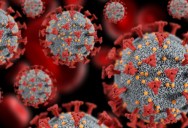Scientists Have Found Strange, Living Viruses On Greenland’s Ice Sheet

If there’s anything Hollywood has taught us about strange and emerging viruses, it’s that they’re probably going to kill a whole bunch of us at once.
I mean, I washed my hands like six times a day for weeks after reading The Hot Zone.
That said, it’s too early to say what effect these large, strange viruses in Greenland might have on the human population.
They are infecting the algae that share their ice sheet, and scientists are wondering whether or not they could actually me minimizing melting.

Viruses are too small to be seen by the eye, and as large as these are, they’re no exception. They are, however, 125 times bigger than normal viruses and bigger than bacteria, too.
Their genomes contain around 2.5 million base pairs.
Giant viruses have been found in all sorts of environments – the sea, soil, and even in human bodies.
These are the first time they’ve been discovered in snow teeming with microalgae, though, and the team thinks they could play an important role in regulating the blooms and slowing the melting process.
The Arctic algae flourish the spring, darkening large swathes of the ice sheet. This limits its ability to reflect sunlight and heightens the melt.

The environment suffers, so researchers are hopeful these viruses could actually make a positive impact.
“We don’t know a lot about the viruses, but I think they could be useful as a way of alleviating ice melting caused by algal blooms. How specific they are and how efficient it would be, we do not know yet. But by exploring them further, we hope to answer some of those questions.”
The team collected samples from the snow and ice habitats and then analyzed the DNA searching for specific giant virus marker genes.
They found sequences matching known giant viruses in almost every one.
They also extracted mRNA, a single-stranded molecule that contains the instructions from DNA that direct cells to make a protein to verify the viruses are active.
“The in the total mRNA sequenced from the samples, we found the same markers as in the total DNA, so we know they have been transcribed. It means that the viruses are living and active on the ice.”

Giant viruses are special because they are able to repair, replicate, transcribe, and translate DNA without the help of a host.
Researchers aren’t sure what these giant viruses infect, but researcher are still trying to figure it out.
“Some of them may be infecting protists while others attack the snow algae. We simply can’t be sure yet.”
In short, hearing “giant viruses” doesn’t always have to be a bad thing.
In this case, they seem pretty helpful.
If you think that’s impressive, check out this story about a “goldmine” of lithium that was found in the U.S. that could completely change the EV battery game.

Sign up to get our BEST stories of the week straight to your inbox.




